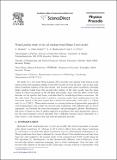Wang–Landau study of the 2d random-bond Blume–Capel model
Author(s)
Malakis, A.; Hadjiagapiou, I. A.; Fytas, N. G.; Berker, A. Nihat
DownloadMalakis-2010-Wang–Landau study of.pdf (296.0Kb)
PUBLISHER_CC
Publisher with Creative Commons License
Creative Commons Attribution
Terms of use
Metadata
Show full item recordAbstract
We study, via a two-stage Wang–Landau (WL) strategy, the random-bond version of the square lattice ferromagnetic Blume–Capel (BC) model, in both the first- and second-order phase transition regimes of the pure model. The second-order phase transition, emerging under random bonds from the second-order regime of the pure model, has the same values of critical exponents as the 2d Ising universality class, with the effect of the bond disorder on the specific heat being well described by double-logarithmic corrections. On the other hand, the second-order transition, emerging under bond randomness from the first-order regime of the pure model, has a distinctive universality class with v=1.30(6) and [β over v]=0.128(5). These results amount to a strong violation of universality principle of critical phenomena, since these two second-order transitions, with different sets of critical exponents, are between the same ferromagnetic and paramagnetic phases. Furthermore, the latter of these two sets of results supports an extensive but weak universality, since it has the same magnetic critical exponent (but a different thermal critical exponent) as a wide variety of 2d systems with and without quenched disorder.
Date issued
2010-02Department
Massachusetts Institute of Technology. Department of PhysicsJournal
Physics Procedia
Publisher
Elsevier
Citation
Malakis, A., A. Nihat Berker, I.A. Hadjiagapiou, and N.G. Fytas. “Wang–Landau Study of the 2d Random-Bond Blume–Capel Model.” Physics Procedia 3, no. 3 (February 2010): 1443–1446.
Version: Final published version
ISSN
18753892